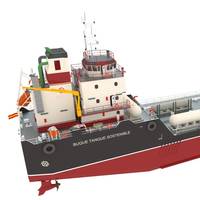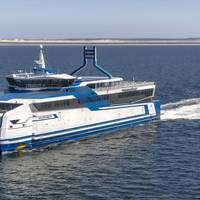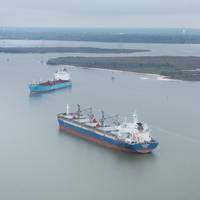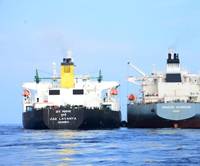Sener Designs Biofuel Tanker Than Can Capture CO2 from Other Ships

Spanish engineering and technology group Sener said Thursday it had completed the conceptual design of a new sustainable biofuel tanker aimed at supplying biofuels during bunkering operations, that is also capable of capturing CO2 from other vessels.The vessel would be able to carry heavy fuel oil (HFO), very low sulfur fuel oil (VLSFO), biofuels and marine gas oils (MGO), and also store the captured CO2 from nearby vessels."The new vessel has been designed to operate in compliance with the energy efficiency and emission reduction requirements of the International Maritime Organization (IMO).
LNG-fueled RoPax Ferry Completes Sea Trials

The first of two new 70-meter liquefied natural gas (LNG)-fueled RoPax ferries for Dutch operator Rederij Doeksen has completed sea trials in the Netherlands.The BMT-designed Willem Barentsz, and sister vessel Willem de Vlamingh, were built by Strategic Marine Shipyard in Vietnam while final outfitting and commissioning were completed by Rederij Doeksen.With an operating area within the Wadden Sea, a UNESCO World Heritage Site, the main focus for Rederij Doeksen led by its managing director Paul Melles was on reducing the environmental impact of the vessel operation.
Op/Ed: Shiphandlers Beware

Was the closing of the Houston Ship Channel for over three days in March 2015 due to the use of Ultra Low Sulphur Fuel Oil (ULSFO)? After reviewing the testimony, and evidentiary material presented by the National Transportation Safety Board (NTSB) regarding the 2015 Conti Peridot’s collision with the Carla Maersk, it is the authors' opinion the report fails to address significant contributing factors. The NTSB has overlooked a serious threat to vessel operations throughout the world.
INTERTANKO Welcomes EMSA Sulphur Inspection Guidance

INTERTANKO issued a press statement today stating its approval for the recently completed European Maritime Safety Agency (EMSA) Sulphur Inspection Guidance supporting the implementation of Council Directive 1999/32/EC. EMSA’s guidance aims to support a harmonized approach for the inspection of ships regarding the sulphur content of marine fuels, ascertaining their compliance, identifying non-compliances and applying control procedures for the enforcement of Council Directive 1999/32/EC.
GAS SHIPS: GAC Helps Meet Rising Indian Demand

GAC’s in-house ship-to-ship transfer expert GAC Transfer Services (GTS) has responded to growing demand for LPG imports and exports of clean products in the Indian Subcontinent with the establishment of a new fully-equipped base in Sri Lanka. Ship-to-ship (STS) equipment such as fenders and hoses, in accordance with industry standards, is stored at GAC’s base in Galle, which is strategically located at the southern tip of the island nation, and is ready to be transported by tug to different locations according to demand and conditions.
Diesel Switch Eliminates Fuel Changeover Problems

With the recent introduction of stringent environmental regulations, such as those from the IMO, ship owners and operators are increasingly obliged to operate their MAN B&W two-stroke main engines on ultra-low sulphur fuels in defined marine zones. Furthermore, CARB (the Californian Air Resource Board) has enforced the use of diesel oils (MDO) or gas oils (MGO) in Californian waters since 1 July, 2009, while European harbours introduced similar requirements at the start of 2010. These new requirements ultimately mean more frequent, running changeovers in fuel type aboard marine vessels.
Air Emission Regulation Update

In March this year, The U.S. Environmental Protection Agency proposal to designate waters off the North American coasts as an Emission Control Area was adopted by IMO, the International Maritime Organization. The North American ECA is a key part of a comprehensive EPA program to address harmful emissions from large ships. Which are the time schedules of upcoming emission regulations? How are marine engine manufacturers preparing for the tighter air emission limits being adopted? Henrik Segercrantz explores.
EU to Develop Sulfur Strategy
The EU is limbering up to set new restrictions on sulfur in marine fuels, if MARPOL Annex VI is not implemented quickly, explains Ian Adams, secretary general of the International Bunker Industry Association (IBIA). At the same time, the European Commission aims to clarify its own directive on sulfur limits for marine diesel oil, which have been subject to different interpretations in different countries. The EC believes that for sulfur oxide, the cost of reducing emissions from ships is now considerably lower than further abatement measures in other sectors. So shipping is in the frame, says Adams. An EU study now underway will quantify ship emissions of SO2…
MCA Issues Sea Discharge Report
The U.K. Maritime and Coastguard Agency (MCA) has released its 2001 survey of reported discharges attributed to vessels and Offshore Oil and Gas Installations operating in the United Kingdom pollution control zone. This report compiled annually by the Advisory Committee on Protection of the Sea (ACOPS) has shown that both the number of incidents of pollution from vessels has reduced as has the amount of oil released into the sea. · 678 accidental or deliberate polluting discharges were identified from vessels and offshore installations operating in the United Kingdom Pollution Control Zone and national waters. This is a reduction of 8.7% over the previous year’s total of 743 discharges. · Offshore oil & gas installations were identified as the source of 71% of the confirmed discharges.





